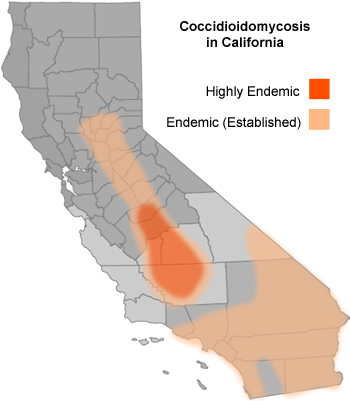
Coccidioidomycosis
Coccidioidomycosis is a disease caused by the spores of the fungus, Coccidioides immitis which is often found in desert regions. It is also known as Coccidiosis; San Joaquin Valley fever; Valley fever.
What is Coccidioidomycosis?
Most people who catch Cocci do not get sick at all; they probably don’t even know they have the disease. Nine out of every ten people who move into America's desert southwest test positive for this fungus within four or five years, but only about %10 of these will actually exhibit symptoms, starting with chest pain, then flu-like symptoms. Cocci is a fungus disease caused by a tiny form of plant life similar to yeast or mildew. The spores, which are like little seeds, are found in dust and are inhaled into the lungs.
Causes
Infection is caused by inhalation of spores which may remain dormant and develop after long dry spells, spreading into the air through the disturbance of soil. About 60% of infections cause no symptoms and are only recognized later by a positive coccidioidin skin test. The disease can have an acute, chronic or disseminated form. Acute pulmonary coccidioidomycosis is almost always mild, with few or no symptoms, and resolves without treatment. The incubation period is 7 to 21 days.
Symptoms
Symptoms only occur in 40% and can include: cough, chest pain,fever, chills, night sweats, headache, muscle stiffness, joint stiffness, neck stiffness, rash, blood-tinged sputum, loss of appetite, weight loss, wheezing, sweating, change in mental status, and sensitivity to light.
Treatment
The acute disease almost always goes away without treatment. Bedrest and treatment of flu-like symptoms until fever disappears may be recommended. Chronic and disseminated forms of the disease are more severe. A doctor will need to prescribe medication.
